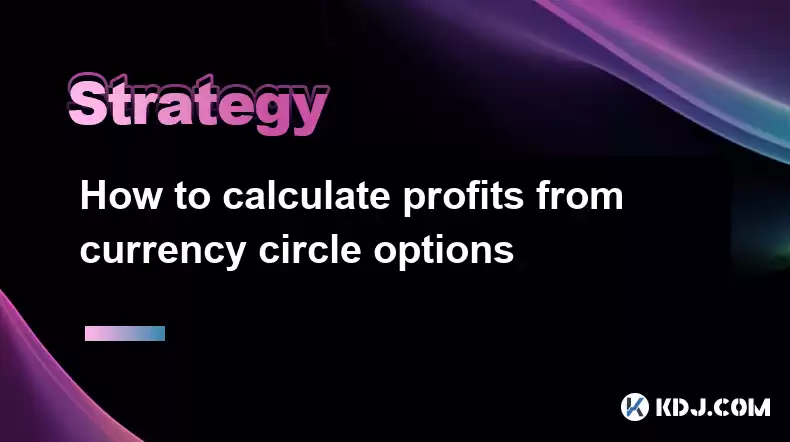-
 bitcoin
bitcoin $110047.851143 USD
-1.37% -
 ethereum
ethereum $3727.617466 USD
-1.30% -
 tether
tether $1.000961 USD
-0.05% -
 bnb
bnb $1114.045467 USD
1.72% -
 xrp
xrp $2.343280 USD
0.14% -
 solana
solana $174.674876 USD
-5.85% -
 usd-coin
usd-coin $0.999999 USD
0.02% -
 tron
tron $0.311757 USD
-2.44% -
 dogecoin
dogecoin $0.183678 USD
-3.76% -
 cardano
cardano $0.627109 USD
-2.07% -
 ethena-usde
ethena-usde $1.000300 USD
0.15% -
 hyperliquid
hyperliquid $36.865760 USD
-2.74% -
 chainlink
chainlink $16.968918 USD
-1.48% -
 stellar
stellar $0.318159 USD
0.47% -
 bitcoin-cash
bitcoin-cash $500.637224 USD
-1.56%
How to calculate profits from currency circle options
To calculate profits from Currency Circle options, traders must analyze the premium, strike price, expiration date, and the underlying asset's price movements, ultimately computing the profit or loss based on the contract's terms.
Jan 08, 2025 at 06:52 pm

- Identify the types of options contracts.
- Calculate the premium paid for the contract.
- Determine the strike price and expiration date of the contract.
- Analyze the underlying asset's price movements.
- Compute the profit or loss based on the contract's terms.
Options contracts come in two main types: calls and puts.
- Call options give the buyer the right, but not the obligation, to buy an underlying asset at a specified price (strike price) before a certain date (expiration date).
- Put options give the buyer the right, but not the obligation, to sell an underlying asset at a specified price (strike price) before a certain date (expiration date).
The premium is the price paid to enter into an options contract. It is typically expressed as a percentage of the underlying asset's price.
- For call options, the premium represents the price paid for the right to buy the asset.
- For put options, the premium represents the price paid for the right to sell the asset.
The strike price is the specified price at which the underlying asset can be bought (in the case of call options) or sold (in the case of put options) under the contract.
The expiration date is the last date on which the options contract can be exercised.
4. Analyze the Underlying Asset's Price MovementsTo determine the potential profit or loss from an options contract, it is essential to analyze the price movements of the underlying asset.
- If the underlying asset's price moves in the direction anticipated, the options contract will likely yield a profit.
- If the underlying asset's price moves in the opposite direction of the anticipation, the options contract will likely lead to a loss.
The profit or loss from an options contract is calculated based on the difference between the underlying asset's price at the expiration date and the strike price, adjusted for the premium paid.
- For call options, if the underlying asset's price is above the strike price at expiration, the profit is the difference between the two minus the premium paid.
- For put options, if the underlying asset's price is below the strike price at expiration, the profit is the difference between the two minus the premium paid.
A: Options and futures are both derivative contracts that give the holder the right to buy or sell an underlying asset. However, options give the holder the option to exercise the contract, while futures contracts obligate the holder to buy or sell the asset at the expiration date.
Q: What are the risks of currency circle options?A: Cryptocurrency options carry substantial risks, including the potential for losing the entire premium paid, as well as the potential for significant losses if the underlying asset price moves significantly against the anticipated direction.
Disclaimer:info@kdj.com
The information provided is not trading advice. kdj.com does not assume any responsibility for any investments made based on the information provided in this article. Cryptocurrencies are highly volatile and it is highly recommended that you invest with caution after thorough research!
If you believe that the content used on this website infringes your copyright, please contact us immediately (info@kdj.com) and we will delete it promptly.
- XRP Price Prediction: Weekend Rollercoaster or Rally?
- 2025-10-12 08:45:16
- Bittensor (TAO): Super Bullish Signals Point to Potential 2x Rally
- 2025-10-11 10:25:12
- Silver Price Correction: Navigating the Dip & Identifying Key SEO Keywords
- 2025-10-11 10:25:12
- Decoding Crypto Trends: Bittensor's Bull Run, Cardano's Dip, and LivLive's Presale Buzz in 'Uptober 2025'
- 2025-10-12 08:45:16
- MoonBull: The Crypto Meme Coin Promising 1000x Gains?
- 2025-10-11 10:30:01
- Crypto Payroll Revolution: Stablecoins, Altcoins, and the Future of Salary Payments
- 2025-10-11 10:30:01
Related knowledge

Practical parameter settings for a Bitcoin multi-timeframe moving average system
Sep 18,2025 at 10:54pm
Optimizing Timeframe Combinations for Bitcoin Trading1. Selecting appropriate timeframes is crucial when building a multi-timeframe moving average sys...

How can I filter out false breakouts in Dogecoin high-frequency trading?
Sep 22,2025 at 01:00am
Understanding False Breakouts in Dogecoin Trading1. A false breakout occurs when Dogecoin's price appears to move beyond a defined support or resistan...

Techniques for identifying tops and bottoms in the Bitcoin on-chain NVT model
Sep 20,2025 at 07:54pm
Understanding the NVT Model in Bitcoin Analysis1. The Network Value to Transactions (NVT) ratio is often described as the 'P/E ratio' of the cryptocur...

What does the surge in open interest in Bitcoincoin futures mean?
Sep 20,2025 at 11:18pm
Understanding the Surge in Dogecoin Futures Open Interest1. A surge in open interest within Dogecoin futures indicates a growing number of active cont...

How can I use the Ethereum USDT premium to gauge market sentiment?
Sep 18,2025 at 11:55pm
Understanding the Ethereum USDT Premium1. The Ethereum USDT premium refers to the price difference between USDT (Tether) traded on Ethereum-based plat...

What should I do if Ethereum staking yields decline?
Sep 20,2025 at 06:18am
Understanding the Causes Behind Declining Ethereum Staking Yields1. The Ethereum network transitioned to a proof-of-stake consensus mechanism with the...

Practical parameter settings for a Bitcoin multi-timeframe moving average system
Sep 18,2025 at 10:54pm
Optimizing Timeframe Combinations for Bitcoin Trading1. Selecting appropriate timeframes is crucial when building a multi-timeframe moving average sys...

How can I filter out false breakouts in Dogecoin high-frequency trading?
Sep 22,2025 at 01:00am
Understanding False Breakouts in Dogecoin Trading1. A false breakout occurs when Dogecoin's price appears to move beyond a defined support or resistan...

Techniques for identifying tops and bottoms in the Bitcoin on-chain NVT model
Sep 20,2025 at 07:54pm
Understanding the NVT Model in Bitcoin Analysis1. The Network Value to Transactions (NVT) ratio is often described as the 'P/E ratio' of the cryptocur...

What does the surge in open interest in Bitcoincoin futures mean?
Sep 20,2025 at 11:18pm
Understanding the Surge in Dogecoin Futures Open Interest1. A surge in open interest within Dogecoin futures indicates a growing number of active cont...

How can I use the Ethereum USDT premium to gauge market sentiment?
Sep 18,2025 at 11:55pm
Understanding the Ethereum USDT Premium1. The Ethereum USDT premium refers to the price difference between USDT (Tether) traded on Ethereum-based plat...

What should I do if Ethereum staking yields decline?
Sep 20,2025 at 06:18am
Understanding the Causes Behind Declining Ethereum Staking Yields1. The Ethereum network transitioned to a proof-of-stake consensus mechanism with the...
See all articles










































































